Hubbard Brook: An 8,000-acre Test Tube
Air Date: Week of September 23, 2016

Concrete structures called gauging weirs are placed within each watershed under scientific study at Hubbard Brook Experimental Forest. The v-notch in the weir allows precise measurements of the quantity of water moving downslope, and scientists gather water samples from the collection basin. (Photo: Jenni Doering)
In the 1950s, the U.S. Forest Service set aside a swath of the White Mountains for forest science research. The Hubbard Brook Experimental Forest has proven invaluable as the site of long-term and groundbreaking studies. Scientists Gene Likens and Dick Holmes helped begin the project and have been involved in research there for decades. They take host Steve Curwood into the forest to explain their discoveries of acid rain and the consequences of clear-cutting.
Transcript
CURWOOD: It’s Living on Earth, I’m Steve Curwood. The White Mountains of New Hampshire house one of the largest ‘test tubes’ in science. Scientists working in the nearly 8,000 acres of Hemlock, Red Spruce, Sugar Maple, and other trees of the Hubbard Brook Experimental Forest have made some of the major scientific discoveries in forest science of the last 50 years. And every year scientists from all over the country gather to compare notes on their research.
[SOUNDS OF A CROWD OF PEOPLE TALKING.]
LAPINE: Oh my gosh, I don’t know what we would do without Hubbard Brook. There’s been research going on here since the 70s, and the long-term record allows us to answer so many questions and we’re really continuing to add to that dataset.
CURWOOD: Lucy Lapine of the University of New Hampshire and Cornell University professor Christie Goodale are among the hundred-odd scientists who came to this session.
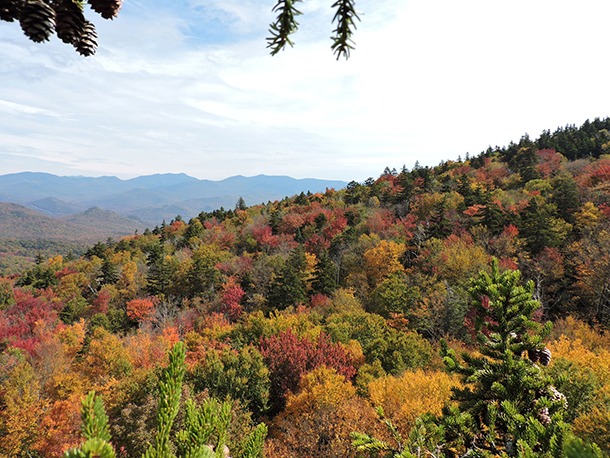
The northern hardwood forest at Hubbard Brook in autumn. The canopy is dominated by deciduous species such as sugar maple, yellow birch, and American beech, with some conifers. (Photo: D. C. Buso)
GOODALE: Hubbard Brook itself is such a well-studied ecosystem and yet there are still so many surprises, and things we can’t explain about how forests work. Even though we’ve been studying this for 40 or 50 years, there are still surprises.
CURWOOD: Surprises have punctuated the work of Gene Likens of the Cary Institute of Ecosystem Studies, one of the cofounders of the Hubbard Brook project. Along with Dick Holmes, a Dartmouth biology professor, he lays out these breakthroughs in "Hubbard Brook: The Story of a Forest Ecosystem".
CURWOOD: I joined them both one warm summer day and Gene described the landscape.
[SOUNDS OF HUBBARD BROOK AND FOREST]

The main Hubbard Brook. (Photo: Jenni Doering)
LIKENS: This is the main Hubbard Brook. We’re at the base of the Hubbard Brook valley, and it’s drained by a network of streams, and this is kind of the summation of all the things that have happened above this point in the valley.
CURWOOD: So, Hubbard Brook as a research station in this forest started in 1955?
LIKENS: Yes.
CURWOOD: Why? Whose idea was this?
LIKENS: Well, the U.S. Forest Service was looking for a place to establish a major hydrological facility, a place to measure all the water, the precipitation and the streamflow and the storage and everything that goes into a water budget for a system. And so they looked carefully all over New England and they evaluated a number of different sites and this one they selected because it had the characteristics that they were looking for, a large bowl-shaped valley, relatively homogeneous vegetation and geology -- We now know this is homogeneous as they thought it might be at that time, -- and then also they thought that it was very likely to have a relatively watertight, geologic basement so that all the water that was flowing, like this river, would be measured accurately, quantitatively, and we wouldn't be confounded by water that was going deep, deep seepage in the ground water.
We started with a simple metaphor that, could we use the chemistry of stream water much like a physician uses the chemistry of blood and urine, and so if that chemistry changes or is different than we expect then something may be going on.
CURWOOD: Dick, this study has been going on here for a long time. What's the power of a longitudinal study?
HOLMES: Well, one starts to see patterns that one can't see in short time, and that gives you things to look for and try to understand what's causing these changes. So, now in 50 years, we have a long dataset to try to look at different kinds of things, everything from the stream water chemistry, as Gene pointed out, to bird population changes over a long time period.
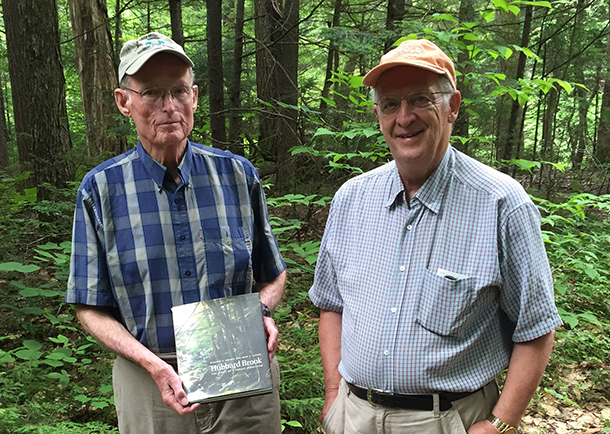
Richard Holmes, left, and Gene Likens are the authors of Hubbard Brook: The Story of a Forest Ecosystem (Photo: Steve Curwood)
CURWOOD: Looking at this stream here, I'm reminded what's probably the most famous about the Hubbard Brook experimental station is the ascertainment of the effects of acid rain. Please tell me that story.
LIKENS: It was actually the discovery of acid rain. In 1963, in July, the first sample rain that we collected was about 100 times more acidic than we thought it should be. We were really shocked. We wondered if it was some mistake we were making. We wondered if it was something unique to the White Mountains and the Hampshire -- This is the Granite State, after all -- and I set up rain collecting stations around the Finger Lakes, nearby Ithaca, New York, and found that the rain chemistry there was just about what we had been measuring in White Mountains, Hubbard Brook. Herb Bormann and I published a paper in Science Magazine saying that it was a regional problem, and it was primarily caused by the emission of sulfur dioxides and nitrogen oxides from the Midwest, primarily in the production of electricity by burning coal and oil in places like Indiana, Ohio, Illinois, Kentucky, and that those pollutants were being transported in the atmosphere to places like this and coming down to us as acid rain, with sulfuric acid and nitric acid being the strong acids. That paper was picked up by the New York Times and featured on the front page and that changed my life forever.
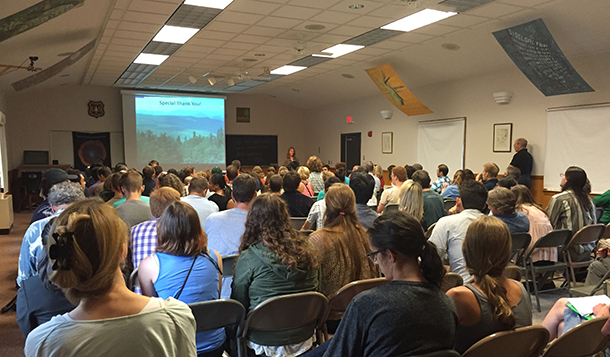
Scientists and students gathered at the 2016 Hubbard Brook Cooperators’ Meeting, a yearly chance for those involved in the Hubbard Brook Ecosystem Study to share their research results and build collaborative friendships. (Photo: Steve Curwood)
CURWOOD: Oh? What happened next?
LIKENS: Everything. So I had phone calls and letters and inquiries from literally all over the world about what was going on. We then were doing other studies. We were trying to answer these questions. Were those pollutants really coming from the Midwest to here? We tried to follow plumes in small aircraft. We had cars on the ground trying to follow plumes that were above us, and if it would rain we would rush out with our collectors and hand hold them and try to collect samples of the rain, really very primitive, but that's all we had. We did try to use some isotopes that were in the coal and see if we could find them in the rain that was falling here. And the data were really quite convincing that that's where the plumes were coming from, the Midwest.
We also wanted to know, and needed to know, how long it had been acid. Was it something new or usual? And so two colleagues and I set up sites in the remotest places that we could find in the world. We had a site in southern Chile. We had a site in the southern tip of Africa. We had a site the middle of the Indian Ocean on an little island, and we found that, yes, these were unusual values, and that the background probably was at a pH of about 5.1, and we were measuring sometimes in the threes. The lowest pH we ever measured here was 2.85, which is really, really very acid. Of course, it was a very controversial issue. The electrical utilities in the Midwest were saying, “No, no, no, not us. We didn't do it”, just like what we here today are saying with climate change, and we were saying, “Yes, yes, yes, you are.” But as a scientist you have to do more than point your finger. You have to collect data that tries to answer the questions quantitatively, and that's what we did.
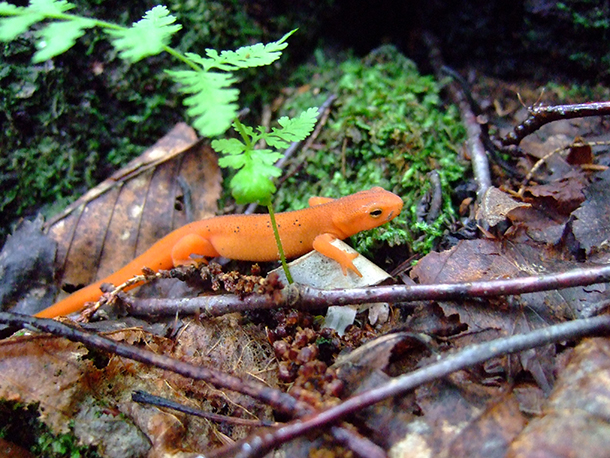
Hubbard Brook Experimental Forest is home to salamanders like the red-spotted newt (Photo: g.h.vandoorn, Flickr CC BY-NC 2.0)
CURWOOD: So you have all this data. What happens next?
LIKENS: Well, then I guess what happens next is to publish. That's what you do as scientists. A lot of really interesting stories there. I gave a lecture once at the University of California, Davis. I didn't realize there was a reporter in the audience. The Sacramento Bee the next morning had a headline in the newspaper, “Prof Says Rain on Acid Trip.”
CURWOOD: [LAUGHS]
LIKENS: Well, in California...but even though it was totally wrong, in terms of what we were talking about, it did provide publicity. In 1990, President George Bush the first signed into the law the first Clean Air Act amendments that dealt specifically with reducing acid rain.
CURWOOD: So talk to me about the effects on the forest then and now.
LIKENS: Standing right here, this forest looks quite healthy. I mean, it's green, it’s lush, but particularly in the upper elevations, in the places where we've done detailed studies, we know that it's not, particularly the Sugar Maple. The Sugar Maple has been impacted quite significantly, primarily through the higher acidity in the soil and, maybe more importantly, the mobilization of aluminum. The acidities that we're talking about are enough to mobilize aluminum. Aluminum is toxic to fine roots of trees, and so Sugar Maple have responded to that with a much increased mortality.
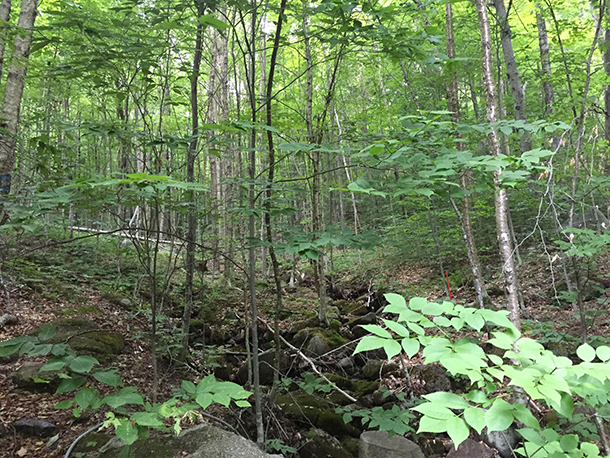
The narrow, packed trunks of hardwood trees, several decades after an experimental clearcut in one watershed. (Photo: Steve Curwood)
Red Spruce is impacted by rain falling on the needles leaching calcium out of the needles, and then the tree, the Red Spruce is much less able to resist cold weather in wintertime. So, in the sort of typical, classical approach we take here at Hubbard Brook, we did a whole watershed scale manipulation.
HOLMES: There’s one big watershed, the Hubbard Brook Valley, which we're sitting next to the stream that it drains to, but then in the upper reaches of the valley itself we've defined nine, small, upper watersheds that we have done various kinds of studies in and experiments with. Various kinds of forest harvesting techniques -- One watershed was clear-cut. One of the experiments was calcium addition to understand whether calcium was a limiting factor or not.
LIKENS: This is my test tube. We wanted to add back all the calcium that we calculated had been leached in the previous 50 years. So calcium silicate was sprinkled all over an entire watershed to replace all the calcium that had been lost. Long story short, calcium is very important. Calcium seems to be a limiting nutrient in these forests that have been so impacted by acid rain.
HOLMES: The forest had slowed in its growth, and this calcium experiment allowed us to experimentally show that calcium was one of the factors that was causing the growth to drop off.
CURWOOD: So, the Clean Air Act amendments of 1990 goes through. What the law calls for, is it strong enough to meet the concerns that you as a scientist have discovered?
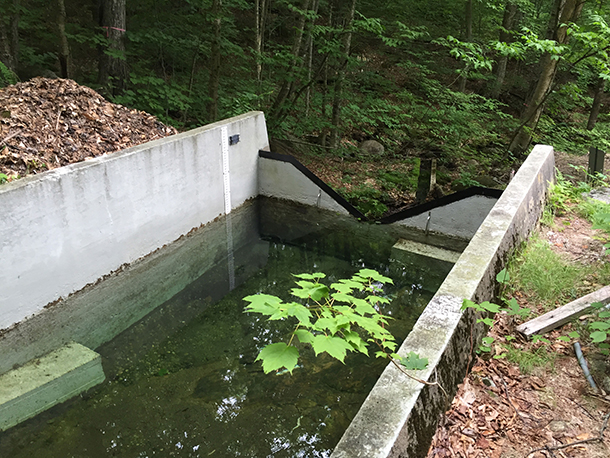
The collection basin and v-notch of a gauging weir (Photo: Jenni Doering)
LIKENS: The new laws have done a lot of good. I think, by all accounts, you have to say there were successful. The acidity of rain here is now about 80 percent less than it was in 1970 when it actually peaked. This is a sensitive system because the rocks have little buffering capacity, and the soils have small amounts of buffering capacity. The acidity of the rain and the snow has leached away a lot of that. We calculate that maybe 50 percent of the available calcium has been leached away by acid rain. So that means we've leached away a lot of the Rolaids and the Tums in the soil if you will. And so, even though the acidity of the rain is much, much less, the soils have much reduced buffering capacity so there's still an impact. It's still with us unfortunately.
CURWOOD: We pull open a gate, lock it behind us, and head higher up in the watershed.
[CREAKY GATE]
CURWOOD: After a short drive, Gene Likens leads Dick and I to the edge of a large concrete basin.
[CAR DOOR SLAMS, WALKING]
[WATER BUBBLING]
LIKENS: This is a gauging weir. It’s a device that forces all the water moving downslope to move through it, and there's a V-notch, and the water flows through that V-notch to tell us how much flow is occurring. We collect not only the water but all the chemicals that are in the water, and that's chemically analyzed. And then eroded particulate matter, and you can see the pile on the other side. So all of the export from this system is quantitatively measured.
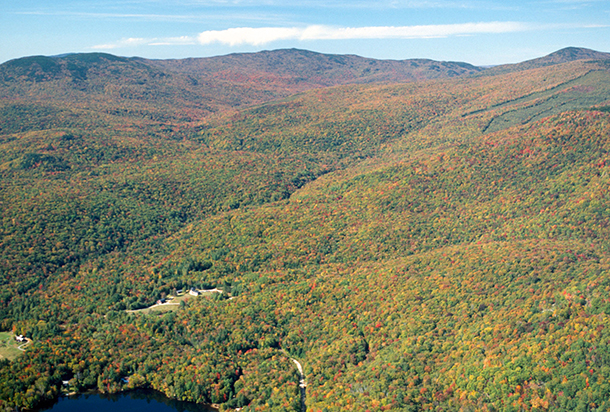
An aerial view looking west of the Hubbard Brook valley in early autumn, 1996, with several experimentally manipulated watersheds at the upper right, and the Robert S. Pierce Ecosystem Laboratory of the U.S. Forest Service and part of Mirror Lake in the foreground at left. (Photo: J. F. Franklin)
CURWOOD: The Hubbard Brook has helped document the effects of clearcutting, acid rain, and now there's a lot of concern, of course, about climate change. What's this research station doing in terms of improving our understanding of the impact of climate change?
HOLMES: Well, I guess the first thing is they're documenting the fact the climate is changing. There are a series of weather stations throughout the valley that have been in operation since the 1950s or early 1960s, and this gives a 50 to 60 year record of temperature changes, precipitation changes.
LIKENS: There's less snow pack. There's more rain and ice storms and hail in the winter time, and we see that those changes that are occurring and the physical features, the temperature and the wetness, affect many organisms. Dick, the earlier bud break and longer growing season.
HOLMES: The time at which leaves come on the trees in the spring so there’s now leafing out earlier than it was 20, 30, 40 years ago. This has an effect on the animal populations, in terms of when the birds arrive and when the insects start to become abundant, and affect the timing of breeding of animal species that are living here in the forest. So far, we haven't detected a negative effect. The birds, for instance, seem to be adjusting to that time shift, but if it gets to be early enough it could impact their success.
LIKENS: So that's interesting. So far, so good in terms of climate you're saying.
HOLMES: Well, so far not bad.
LIKENS: Not bad.

Dick Holmes, Steve Curwood and Gene Likens at one of the upper watersheds in the forest (Photo: Jenni Doering)
[LAUGHTER]
CURWOOD: These days the Forest Service limits clear-cuts to 100 acres or less, a regulation that’s based in part on the research that was conducted at Hubbard Brook Experimental Forest. Dick Holmes recalled that research sometimes involved clear-cutting entire watersheds.
HOLMES: Well, these were done for various purposes, but overall they give us results showing what the effects of different kinds of harvesting techniques are on the forest systems, and one of the first ones that was done, the first one, was Watershed Two, which was an area that was clear-cut and the trees were left in place rather than removed. They were just dropped, chopped up a bit and left as debris on the forest floor. And one of the results of that was that the water flow from that system increased drastically. Then, when the chemistry of the water was sampled, it was found that the nitrate level in the water was very, very high. In fact, it was so high that it didn't meet the public health standards. So, removing vegetation changed the water chemistry, in making it less suitable for human use. And so that caused a major concern among forestry people, lumbermen, who were cutting, if they were going to clear-cut forests which is an official way of getting wood off from their perspective, it has these negative effects. People went out to other commercial clear-cuts to see if the same effect was found out there, and it was. And that led to a lot of discussion about whether you should clear-cut or not, or how big an area you should clear cut, whether you should have small areas that have less impact, this sort of thing. This modified eventually some of the forestry practices in the White Mountain National Forest, at least, and probably elsewhere.
LIKENS: Yeah, we tried to purpose a set of guidelines for how you could harvest timber by more massive clearcutting operations. Because until we have some substitute for wood totally, we're going to need wood. We're going to need paper and products that we collect and harvest from a landscape like this. We needed to know if there was a better way to do it, a less harmful, environmental way, and so we purposed a set of guidelines about how big cuts should be, what kinds of slopes should be involved, whether they would be cut very often or not. We proposed that logs shouldn't be skidded down stream channels, which they were. They shouldn't be cut more often than once every 75 years. The Forest Service now has a regulation that they shouldn't be cut more than once every 100 years, so that's good.
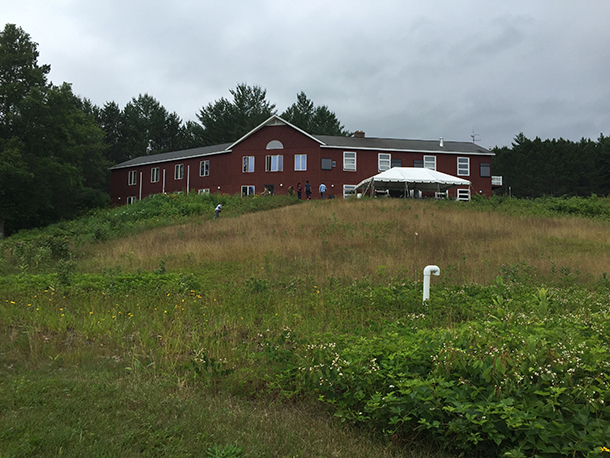
The Robert S. Pierce Ecosystem Laboratory, named in memory of one of the founders of the Hubbard Brook Ecosystem Study, serves as headquarters for the U.S. Forest Service staff who manage the forest. (Photo: Steve Curwood)
CURWOOD: You must feel pretty good about having done this research. You've had a tremendous impact on a vast amount of territory, ecosystem, lives.
LIKENS: Well, yeah, I do actually. I'm not sure how humble that statement is, but the impact on the natural system that I care deeply about, and was being severely negatively impacted, to help be able to find out why and to understand how it can be protected, one, with the 1990 Clean Air Act Amendments that reduced the source -- That's the main thing, cutting back on what's causing the problem -- and then management manipulations that might be helpful on a more local scale, protect beautiful natural systems and a vital natural system. This system provides us with clean air, clean water, I mean, all those ecosystem services that we as humans depend upon.
CURWOOD: Richard Holmes and Gene Likens are authors of “Hubbard Brook: The Story of a Forest Ecosystem”. Thank you, gentlemen, for taking the time.
LIKENS: Thank you.
HOLMES: Thank you.
Links
U.S. Forest Service on Hubbard Brook Experimental Forest (HBEF)
Living on Earth wants to hear from you!
Living on Earth
62 Calef Highway, Suite 212
Lee, NH 03861
Telephone: 617-287-4121
E-mail: comments@loe.org
Newsletter [Click here]
Donate to Living on Earth!
Living on Earth is an independent media program and relies entirely on contributions from listeners and institutions supporting public service. Please donate now to preserve an independent environmental voice.
NewsletterLiving on Earth offers a weekly delivery of the show's rundown to your mailbox. Sign up for our newsletter today!
 Sailors For The Sea: Be the change you want to sea.
Sailors For The Sea: Be the change you want to sea.
 The Grantham Foundation for the Protection of the Environment: Committed to protecting and improving the health of the global environment.
The Grantham Foundation for the Protection of the Environment: Committed to protecting and improving the health of the global environment.
 Contribute to Living on Earth and receive, as our gift to you, an archival print of one of Mark Seth Lender's extraordinary wildlife photographs. Follow the link to see Mark's current collection of photographs.
Contribute to Living on Earth and receive, as our gift to you, an archival print of one of Mark Seth Lender's extraordinary wildlife photographs. Follow the link to see Mark's current collection of photographs.
 Buy a signed copy of Mark Seth Lender's book Smeagull the Seagull & support Living on Earth
Buy a signed copy of Mark Seth Lender's book Smeagull the Seagull & support Living on Earth

